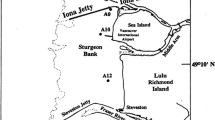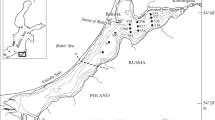Abstract
Organic and carbonate carbon and textural properties of the substrates underlyingHalodule wrightii andThalassia testudinum sea grass beds in the intertidal zone of St. Andrew Bay, Florida were compared to adjacent unvegetated sand flats by physiographic divisions within the bay and to the subtidal slopes of the bay. Sea grass and sand flat sediments were principally fine-grained quartz sands. The mean particle-size of the sea grass sediments were finer-grained than those of the sand flats only in the west arm and lagoon of the bay. Size-frequency distributions of the sea grass sediments were generally slightly more negatively skewed and more leptokurtic than those of the sand flats. The sea grass sediments were less well sorted than were the sand flat sediments. The average organic and carbonate carbon contents of the sea grass beds were 1.9-fold greater than that of the sand flats but much less than that of the subtidal sea grass meadows. In the areas of pollution, sea grasses were absent; near this areaHalodule wrightii was the dominant sea grass.
Similar content being viewed by others
Literature Cited
Cooke, C. W. 1939. Scenery of Florida interpreted by a geologist.Fla. Geol. Surv. Bull. 17. 118 p.
Emery, K. O. 1960. The sea off southern California. John Wiley and Sons, Inc., N. Y. 366 p.
EPA. 1975. Water quality study of St. Andrew Bay, Florida. National Enforcement Center, Denver, Co., and Region IV, Atlanta, Ga. 70 p.
Folk, R. L. 1968. Petrology of sedimentary rocks. Hemphill's, Drawer M, University Station, Austin, Tx. 170 p.
Folk, R. L., andW. C. Ward. 1957. Brazos River bar: a study in the significance of grain size parameters.J. Sediment. Petrol. 27:3–26.
Ginsburg, R. N., andH. Lowenstam. 1958. The influence of marine bottom communities on the depositional environment of sediments.J. Geol. 66:310–318.
Kelly, K. L., and D. B. Judd. 1965. The ISCC-NBS method of designating colors and a dictionary of color names. U.S. Dept. Comm., Natl. Bur. Standards C-553. 158 p.
Krumbein, W. C., andF. J. Pettijohn. 1938. Manual of sedimentary petrography. Appleton-Century-Crofts, Inc., N.Y. 549 p.
Marmer, H. A. 1954. Tides- and sea level in the Gulf of Mexico.U. S. Fish Wildl. Serv. Fish. Bull. 55:101–118.
Marshall, N., andK. Lucas. 1970. Preliminary observations on properties of bottom sediments with and without eelgrass,Zostera marina, cover.Proc. Natl. Shellfish. Assoc. 60:107–111.
McNulty, J. K., W. N. Lindall, Jr. and J. E. Sykes. 1972. Cooperative Gulf of Mexico estuarine inventory and study, Florida: Phase 1, area description. NOAA Tech. Report NMFS Circ-368. 126 p.
Munsell Color Company. 1929–1965. Munsell book of color: pocket edition. Munsell Color Co., Inc., Baltimore, Md. 40 plates.
Petta, T. J., andL. C. Gerhard. 1977. Marine grass banks—a possible explanation for carbonate lenses, Tepee Zone, Pierre shale (Cretaceous), Colorado.J. Sediment. Petrol. 47:1018–1026.
Salsman, G. G., W. H. Tolbert, andR. G. Villars. 1966. Sand-ridge migration in St. Andrew Bay, Florida.Marine Geol. 4:11–19.
Scoffin, T. P. 1970. The trapping and binding of subtidal carbonate sediments by marine vegetation in Bimini Lagoon, Bahamas.J. Sediment. Petrol. 40:249–273.
Shepard, F. P. 1954. Nomenclature based on sandsilt-clay ratios.J. Sediment. Petrol. 24:151–158.
Thayer, G. W., D. A. Wolfe, andR. B. Williams. 1975. The impact of man on seagrass systems.Am. Sci. 63:288–296.
Wood, E. J. F., W. E. Odum, and J. C. Zieman. 1969. Influence of sea grasses on the productivity of coastal lagoons. Lagunas Costeras, Un Simposio. Mem. Simp. Intern. Lagunas Costeras, UNAM-UNESCO, Nov. 28–30, 1967, Mexico, D. F. p. 495–502.
Author information
Authors and Affiliations
Additional information
Contribution Number 79-13PC. Southeast Fisheries Center, National Marine Fisheries Service, NOAA, Panama City Laboratory, 3500 Delwood Beach Road, Panama City, Florida 32407.
Rights and permissions
About this article
Cite this article
Grady, J.R. Properties of sea grass and sand flat sediments from the intertidal zone of St. Andrew Bay, Florida. Estuaries 4, 335–344 (1981). https://doi.org/10.2307/1352158
Issue Date:
DOI: https://doi.org/10.2307/1352158




